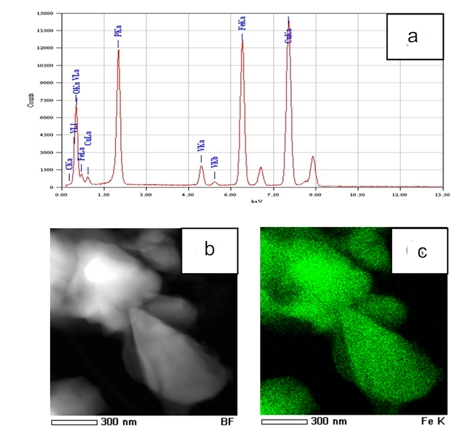
Supervalent doping of LiFePO4 for enhanced electrochemical performance
Abstract
Keywords
Full Text:
PDFReferences
Yamada A, Chung SC, Hinokuma K. Optimized LiFePO4 for lithium battery cathodes. J Electrochem Soc. 2001;148(3):A224-9. doi:10.1149/1.1348257
Ravet N, Chouinard Y, Magnan JF, Besner S, Gauthier M, Armand M. Electroactivity of natural and synthetic triphylite. J Power Sources. 2001;97-98:503-507. doi:10.1016/S0378-7753(01)00727-3
Chung SY, Chiang YM. Microscale Measurements of the Electrical Conductivity of Doped LiFePO4. Electrochem Solid-State Lett. 2003;6(12):A278-81. doi:10.1149/1.1621289
Prosini PP, Lisi M, Zane D, Pasquali M. Determination of the chemical diffusion coefficient of lithium in LiFePO4. Solid State Ionics. 2002;148(1-2):45-51. doi:10.1016/S0167-2738(02)00134-0
Fisher CAJ, Prieto VMH, Islam MS. Lithium battery materials LiMPO4 (M = Mn, transport Fe, Co, and Ni): Insights into defect association, mechanisms, and doping behavior. Chem Mater. 2008;20(18):5907-15. doi:10.1021/cm801262x
Wang L, Li Z, Xu H, Zhang K. Studies of Li3V2(PO4)3 Additives for the LiFePO4-Based Li Ion Batteries. J Phys Chem C. 2008;112:308-12. doi:10.1021/jp0758014
Omenya F, Chernova NA, Upreti S, Zavalij PY, Nam KW, Yang XQ, Whittigham MS. Can vanadium be substituted into LiFePO4? Chem Mater. 2011;23(21):4733-40. doi:10.1021/cm2017032
Xiang JY, Tu JP, Zhang L, Wang XL, Zhou Y, Qiao YQ, Lu Y. Improved electrochemical performances of 9LiFePO4·Li3V2(PO4)/C composite prepared by a simple solid-state method. J Power Sources. 2010;195(24):8331-5. doi:10.1016/j.jpowsour.2010.06.070
Ma J, Li B, Du H, Xu C, Kang F. The Effect of Vanadium on Physicochemical and Electrochemical Performances of LiFePO4 Cathode for Lithium Battery. J Electrochem Soc. 2011;158(1):A26-32. doi:10.1149/1.3514688
Zhang LL, Liang G, Ignatov A, Croft MC, Xiong XQ, Hung IM, Huang Y H, Hu XL, Zhang WX, Peng YL. Effect of vanadium incorporation on electrochemical performance of LiFePO4 for lithium-ion batteries. J Phys Chem C. 2011;115(27):13520-7. doi:10.1021/jp2034906
Chiang CY, Su HC, Liu PJ, Hu CW, Sharma N, Peterson VK, Hsieh H W, Lin YF, Chou WC, Lee CH, Lee JF, Shew BY. Vanadium substitution of LiFePO4 cathode materials to enhance the capacity of LiFePO4-based lithium-ion batteries. J Phys Chem C. 2012;116(46):24424-9. doi:10.1021/jp307047w
Zhong S, Wu L, Liu J. Sol–gel synthesis and electrochemical properties of 9LiFePO4·Li3V2(PO4)3/C composite cathode material for lithium ion batteries. Electrochim Acta. 2012;74:8-15. doi:10.1016/j.electacta.2012.03.181
Wang GX, Bewlay S, Needham SA, Liu HK, Liu RS, Drozd VA, Lee J F, Chen J M. Synthesis and characterization of LiFePO4 and LiTi0.01Fe0.99PO4 cathode materials. J Electrochem Soc. 2006;153(1):A25-31. doi:10.1149/1.2128766
Wang ZH, Pang QQ, Deng KJ, Yuan LX, Huang F, Peng YL, Huang YH. Effects of titanium incorporation on phase and electrochemical performance in LiFePO4 cathode material. Electrochim Acta. 2012;78:576-84. doi:10.1016/j.electacta.2012.06.067
Fang H, Liang G, Zhao L, Wallace T, Arava H, Zhang LL, Ignatov A, Croft MC. Electrochemical Properties of Cathode Material LiFePO4 with Ti Substitution. J Electrochem Soc. 2013;160(5):A3148-52. doi:10.1149/2.024305jes
Koenig GM, Jr, Ma J, Key B, Fink J, Low KB, Shahbazian-Yassar R, Belharouak I. Composite of LiFePO4 with titanium phosphate phases as lithium-ion battery electrode material. J Phys Chem C. 2013;117(41):21132-8. doi:10.1021/jp4074174
Huang H, Yin SC, Kerr T, Taylor N, Nazar LF. Nanostructured composites: A high capacity, fast rate Li3V2(PO4)3/carbon cathode for rechargeable lithium batteries. Adv Mater. 2002;14(21):1525–8. doi:10.1002/1521-4095(20021104)14:21<1525::AID-ADMA1525>3.0.CO;2-3
Belous AG, Novitzkaya G N, Polyanetzkaya SV, Gornikov YuI. Study of Complex Oxides of Composition La//2/////3// minus //xLi//3//xTiO//3. Neorg Mater. 1987;23(3):470–2.
Patoux S, Masquelier C. Lithium insertion into titanium phosphates, silicates, and sulfates. Chem Mater. 2002;14(12):5057-68. doi:10.1021/cm0201798
Kosova NV, Devyatkina ET, Slobodyuk AB, Petrov SA. Submicron LiFe 1-yMnyPO4 solid solutions prepared by mechanochemically assisted carbothermal reduction: The structure and properties. Electrochim Acta. 2012;59(1):404-11. doi:10.1016/j.electacta.2011.10.082
Kosova NV, Podgornova OA, Devyatkina ET, Podugolnikov VR, Petrov SA. Effect of Fe2+ substitution on the structure and electrochemistry of LiCoPO4 prepared by mechanochemically assisted carbothermal reduction. J Mater Chem A. 2014;2(48):20697-705. doi:10.1039/c4ta04221b
DOI: https://doi.org/10.15826/chimtech.2015.2.4.030
Copyright (c) 2015 N. V. Kosova, O. A. Podgornova

This work is licensed under a Creative Commons Attribution 4.0 International License.
Chimica Techno Acta, 2014–2025
eISSN 2411-1414
Copyright Notice






